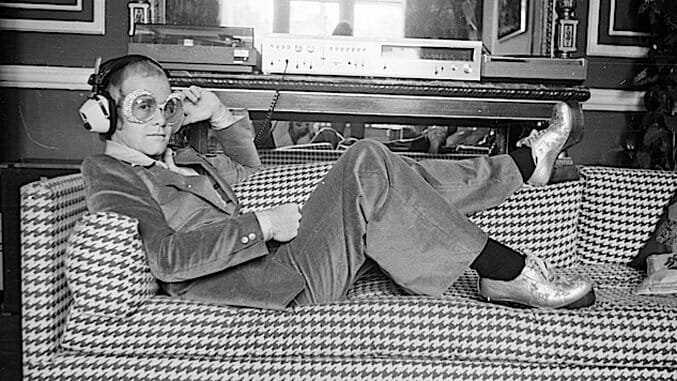Exclusive: Listen to Elton John Become a Star on His First U.S. Tour in 1970
From the Paste Vault: unique recordings of the shows that cemented his legend.
Music Features elton john
This week marks the anniversary of Elton John’s first ever concert in the United States, at The Troubadour in Los Angeles, on Aug. 25, 1970. By all appearances, it was an event. The rising star was introduced by an established star, Neil Diamond. David Crosby and Graham Nash were in attendance, and a row of seats was reserved for Quincy Jones. Bob Dylan would visit with John backstage before the four-night stand ended, and John Lennon called John “the first new thing that’s happened since we happened.”
The Los Angeles Times’s Robert Hilburn wrote that night: “He’s going to be one of rock’s biggest and most important stars.” Twenty years later, Rolling Stone rated John’s introduction to American audiences among the 20 most important concerts in the history of rock ‘n’ roll.
Thanks to the Paste Vault, we can hear what was captivating the music world thanks to a recording of a show just a few months later, at Cleveland’s Music Hall. By Nov. 26, 1970, John was a full-fledged star not just with industry insiders but an American public right at home with his influences of The Band, Buffalo Springfield, Neil Young and late-period Beatles.
John talked about this quick rise to stardom with Rolling Stone at the time. “On the last tour, we were getting $500 a week at the Troubadour in L.A. With eight people. In San Francisco, Doug Weston upped it to $750. Ungano’s in New York still offered me $75 a night. But the States … in Philadelphia the people were all clapping, I was up on the grand [piano] mashin’ about with my feet, I just gave them a signal with my hand and the whole crowd was standing. Fantastic.”
It was a good thing, because John turned down $1,000 a night (via his prescient manager) to tour the states supporting Jeff Beck, who was pulling in $10,000 a show and offered John a 10% split.
Like every rise to stardom, it seemed like fate was at work. John’s partnership with lyricist Bernie Taupin materialized only after Taupin’s mother mailed in an application to become half of a songwriting team; Taupin had thrown it in the garbage. Later, John’s career as a performer arose after he failed to sell enough of his songs. Then, he was able to release “Your Song” as his groundbreaking single only because Three Dog Night chose not to release it in order to give John a chance to make it in the States. John was barely a driving force behind his own stardom, which happened almost organically.
Taupin and John were so prolific that John would often write music to Taupin’s lyrics within an hour after receiving them. By the time of the Cleveland show, John’s third album, Tumbleweed Connection, had already been out for three weeks. The album is far more stripped down than Elton John, the follow up to his debut, Empty Sky. The trio of John, drummer Nigel Olsson and bassist Dee Murray provided a signature sound sans any guitar, but a sound that John would soon ditch for something far more commercial. Most of Tumbleweed seems straight out of a Western.
Let’s start at the beginning with the song that best exemplified the new trio’s American sound: “Amoreena,” off Tumbleweed Connection. It’s a forgotten John classic whose only claim to fame is opening the Sidney Lumet movie Dog Day Afternoon.
John made piano-playing a performance focal point like no artist since Jerry Lee Lewis, and it’s the highlight of the back-half of “Take Me to the Pilot”, with its seemingly improvisational interplay between John, Olson and Murray. The playing itself is honky tonk and rollicking.
John’s performance rises to a virtuosic level on “Sixty Years On,”, which, like “Take Me to the Pilot,” is from his second album, then all of seven months old.
Finally, his music and influences are combined in a medley led by “Burn Down the Mission” and including the Elvis Presley-popularized “My Baby Left Me” (at about the 7:30 mark) and The Beatles’ “Get Back” (12:15).
John’s 1970 tour and rapid rise in popularity were later memorialized for eternity on “Captain Fantastic and the Brown Dirt Cowboy,” the title track from his 1975 album. John was the former, Taupin the latter.
And all this talk of Jesus
Coming back to see us
Mmm mmm couldn’t fool us
For we were spinning out our lines
Walking on the wire
Hand in hand went music and the rhyme
The Captain and the Kid
Stepping in the ring
From here on sonny sonny sonny, it’s a long and lonely climb
In just six years, John released an incredible nine studio albums: Empty Sky, Elton John, Tumbleweed Connection, Madman Across the Water, Honky Chateau, Don’t Shoot Me I’m Only the Piano Player, the epic double-LP Goodbye Yellow Brick Road, Caribou and finally Captain Fantastic and the Brown Dirt Cowboy. But the road to the greatest singer/songwriter career in music history didn’t start in the Land of Oz. It started in a former coffee house on La Cienega Boulevard.